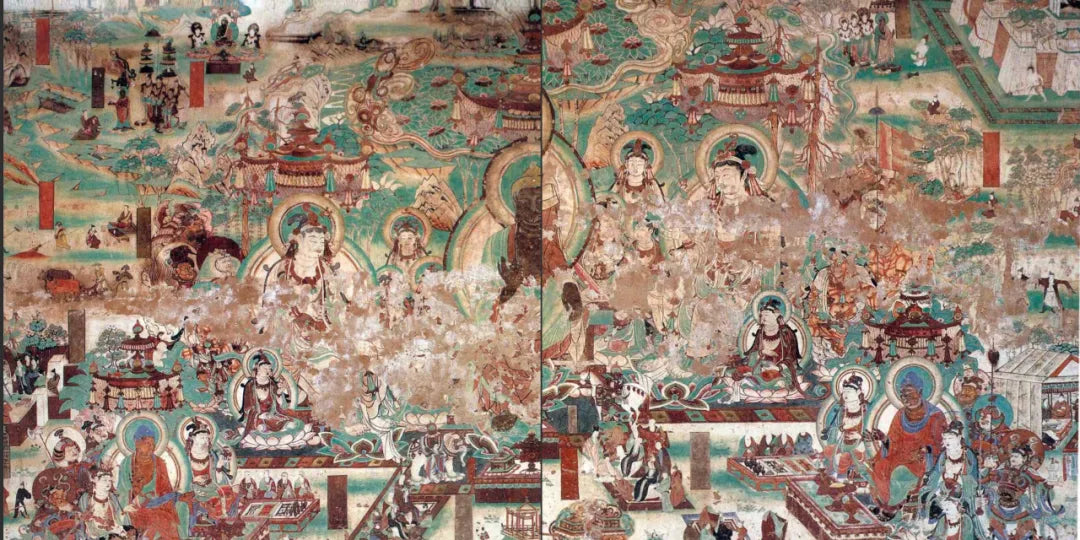
Tibet in the Dunhuang Murals

The Tibetan Tsanpo in Cave 237 of the Mogao Caves, Dunhuang.
A work from the period of Tibetan rule over Dunhuang.

The Tibetan Tsanpo in Cave 360 of the Mogao Caves, Dunhuang.
A work from the period of Tibetan rule over Dunhuang.

The Tibetan Tsanpo in Cave 9 of the Mogao Caves, Dunhuang.
A work from the period of Tibetan rule over Dunhuang.

"The Mourning of Monarchs from Various Nations" on the north wall of Cave 158 in the Mogao Caves, Dunhuang.
The Tibetan Tsanpo is depicted on the far left.
A work from the period of Tibetan rule over Dunhuang.

On the south side of the east wall of Cave 159 in the Mogao Caves, Dunhuang.
A depiction of the Tibetan Tsanpo paying homage to the Buddha in the Vimalakirti Sutra illustration.
A work from the period of Tibetan rule over Dunhuang.

The Kunlun slave driving the lion in the "Manjusri Attending the Assembly" mural in Cave 159 of the Mogao Caves, Dunhuang.
His expression is tense, and the portrayal is vivid.
A willow tree and a stone stele.
In the spring of 823 AD, the sunlight on the plateau was not as intense as usual, and the occasional cold wind still carried the sharpness of winter. In front of the Jokhang Temple, the sapling planted by Princess Wencheng years ago, after enduring over a hundred springs and autumns, would once again gracefully drape its branches and leaves, embracing a new chapter of history. On February 14th of that year, under the witness of Tang and Tibetan officials, a massive stone stele was firmly erected in the ground before it. From then on, this pair—the great tree and the stele—stood like the spirit and strength of the nation, one before the other, one inside and one outside, guarding the peace of this land.

"Princess Willow in Front of the Jokhang Temple," 1978
Oil on canvas, 57cm x 44.5cm
Work by Zhang Ying
Amid the weathering of time, the Tibetan and Chinese inscriptions on the stele have grown increasingly faint, yet the stories behind the characters seem to become clearer and more profound. When we face this forest of text that condenses decades of history into strings of names, the words "Zhang Khri Sum Rje" (ཞང་ཁྲི་སུམ་རྗེ) still exude an air of authority. About thirty years before the erection of this stele, this very Zhang Khri Sum Rje was leading troops across the deserts of Shazhou, now Dunhuang, in the northeastern part of Tibet. At that time, relying on a strategy of siege, he spent years forcing Shazhou into a state of "exhausted provisions and weapons," leading to its fall and marking the beginning of over sixty years of Tibetan rule over Dunhuang. Even at the time the Jokhang Temple stele was erected, Dunhuang remained under Tibetan control.

Cave 361 of the Mogao Caves, Dunhuang.
A representative cave from the period of Tibetan rule over Dunhuang.
Tibetan occupation of Dunhuang.
Although the exact year of the Tibetan occupation of Dunhuang is debated (777; 781; 785; 786; 787; 788), the end of their rule is widely agreed upon: 848. During this period, "Tibetan ethnic rule had a profound impact on Dunhuang, influencing politics, economy, culture, ethnic relations, and many other aspects... breaking the centuries-old traditional pattern dominated by Han culture in Dunhuang" (quoted from Research on Dunhuang Caves during the Tibetan Rule Period).
The Tibetan occupation seemed to bring a fresh stimulus to Dunhuang, which had been in a state of stagnation. During this time, Dunhuang's art experienced significant development: "Over forty new caves were excavated, and more than twenty caves from the High Tang period that were left unfinished were restored and completed, an astonishing number" (quoted from An Introduction to Dunhuang Cave Art). In terms of artistic style, Tibetan culture enriched the content of Dunhuang murals, as evidenced by: an increase in the number of sutra illustration paintings, along with the emergence of various Tibetan-themed subjects; the appearance of Tibetan donor figures in the murals; a shift from the rich, heavy, and luxurious style of the High Tang to a more elegant and fluid approach in lines, forms, and coloring; and a change in composition, where a single mural was divided into multiple sections, incorporating screen paintings, thus altering the overall structure of mural creation. Here, we will present a few Dunhuang murals influenced by Tibetan culture.

The three musicians in the "Manjusri Attending the Assembly" mural in Cave 159 of the Mogao Caves, Dunhuang.
They are playing the flute, sheng, and clappers, respectively.
"Rhythm is embodied in their forms, music flows through the brushstrokes, combining both form and spirit, with exquisite expression and appearance.
They are among the finest examples of musical figures in Dunhuang art."
The Tibetan Tsanpos in the Dunhuang Murals
The *Portrait of the Tibetan Tsanpo Paying Homage to the Buddha* in Cave 159 of the Mogao Caves is a classic example of Tibetan figures appearing in Dunhuang murals. This painting is part of the *Vimalakirti Sutra Illustration*, and during the Tibetan rule, a total of nine such illustrations were created. These murals depict the layman Vimalakirti feigning illness and Manjusri coming to "inquire about his health." Typically, an emperor from Central China is depicted beneath Manjusri, but during this period, the figures paying homage in the sutra illustrations were replaced by Tibetan Tsanpos.

The Tibetan Tsanpo in Cave 159 of the Mogao Caves, Dunhuang.
In this mural in Cave 159, a total of eight Tibetan figures are depicted, with the fourth figure, dressed in a white lapel robe, representing the Tibetan Tsanpo. He "wears a leather belt, carries a short sword, shows green trousers with red edges, black boots, and a 'Tsanxia hat,' with hair hanging down both temples." In front of and behind him are Tibetan attendants holding incense burners or flowers. The two women at the end, wearing Han-style clothing, are now believed to be the Tsanpo's consorts. In addition to Cave 159, images of Tibetan Tsanpos paying homage to the Buddha also appear in Caves 9, 231, and 360, among others. These figures share similar forms, suggesting a common source of inspiration.

Partial view of the image above.

Cave 220 of the Mogao Caves, Dunhuang.

The Tibetan donor figures in Cave 220 of the Mogao Caves, Dunhuang.
A work from the period of Tibetan rule over Dunhuang.
On the north wall of Cave 158 of the Mogao Caves, where a reclining Buddha stretches across, there is a mural titled *The Mourning of Monarchs from Various Nations*. It depicts the grief of various princes after the Buddha's nirvana. The figure on the far left, "wearing a high turban-like crown, with braided hair tied into a bun behind the ears, dressed in an inner garment with a crossed collar and an outer robe with a flipped lapel and left-exposed long sleeves, is the Tibetan Tsanpo."

*The Mourning of Monarchs from Various Nations* on the north wall of Cave 158 of the Mogao Caves.
A work from the period of Tibetan rule over Dunhuang.


Partial detail of the image above: Expressing grief by stabbing the chest with a sword.
A Tibetan groom and a Han bride.
Among all the wedding scenes depicted in the Dunhuang murals, the wedding scene in Cave 25 of the Yulin Caves is undoubtedly the most studied by scholars, as it portrays a Tibetan groom and a Han bride performing a wedding ceremony in the Dunhuang region. In the scene, a "Tibetan man with a red headband and wearing a robe" is kneeling, accompanied by three women. The central figure, with towering brocade flowers in her hair, is his bride, while the two women on either side are her bridesmaids. The hairstyles and clothing of the three women are typical of Han Chinese style. The ceremony they are performing is the "man kneeling, woman bowing" ritual, commonly seen in Dunhuang wedding murals.

Full view of the *Maitreya Sutra Illustration* on the north wall of Cave 25 of the Yulin Caves (mosaic).

The Tibetan-Han intermarriage scene in the lower right section of the north wall of Cave 25 of the Yulin Caves.
Additionally, this wedding scene is part of the *Maitreya Sutra Illustration* on the north wall of the cave, located in the lower right section. In the lower left corner of this painting, there is a "T-shaped" Tibetan inscription. Because "the handwriting, ink color, and content match the mural," it is speculated that "the Tibetan text was written first according to the size of the label, and then the frame was painted." Professors Xie Jisheng and Huang Weizhong deciphered the inscription as: "The younger brother of the Cao family commissioned this holy painting, which is dedicated to the merit of 'Shangxi,' excellent!"


Tibetan inscription in the lower left section of the north wall of Cave 25 of the Yulin Caves.
The term "Shangxi" (ཤང་ཤེའི) is identified by the two professors as the famous monk-minister "Sangxi" (སང་ཤི) from the period of Trisong Detsen, mentioned in Tibetan historical texts such as the *Ba Tradition*. Whether these two figures are the same person or not, the Sangxi mentioned in the *Ba Tradition* and other texts is connected to another Dunhuang mural we are about to discuss: the *Map of Mount Wutai*.

The *Map of Mount Wutai* in the collection of the Rubin Museum.
Mount Wutai and Tibet.
The sacred legends of Mount Wutai had undoubtedly reached Tibet long ago. This is evidenced by texts from the period of Trisong Detsen (?-797 AD), particularly the Wa Tradition (an earlier version of the Ba Tradition), which already contain stories related to Mount Wutai. Among these, the most famous is the tale of Sangxi and four other Tibetan envoys who journeyed to Mount Wutai.

The Manjusri Attending the Assembly on the west wall of Cave 220 of the Mogao Caves.
Below it is the Map of Mount Wutai.
This work is a masterpiece from the period of Tibetan rule.
The expanded version of the *Ba Tradition* records that Sangxi and his four companions, upon arriving in Central China, were highly favored by the emperor, who wanted to appoint them as inner court officials. However, Sangxi insisted on obtaining Buddhist scriptures and returning to Tibet. Later, the five of them journeyed to Mount Wutai, but for various reasons, the other four were unable to reach the summit. In the end, after paying homage at the Manjusri Hall, Sangxi obtained a map of Mount Wutai based on this experience and successfully brought it back to Tibet.

The *Map of Mount Wutai* in the lower section of the north side of the west wall of Cave 159 of the Mogao Caves.
Although the original text is intertwined with mystical legends, the account of Sangxi obtaining the *Map of Mount Wutai* is highly credible. This is because "the earliest appearance of the *Map of Mount Wutai* in Dunhuang murals dates back to the period of Tibetan rule." Moreover, among the seven existing *Maps of Mount Wutai* in the Mogao Caves, four were created during this period, found in Caves 159, 222, 237, and 361.



The *Manifestation of Mount Wutai* in Cave 222 of the Mogao Caves, Dunhuang.
The arrow points to an image labeled "Manifestation of Manjusri Bodhisattva."
Even more intriguing is that the earliest surviving record of Mount Wutai, the *Ancient Records of Qingliang*, mentions that during the Longshuo era of Emperor Gaozong of Tang (661-663), a Han Chinese monk named Hui Ze, along with a palace attendant, visited Mount Wutai to "inspect the sacred sites." After reporting their findings, Hui Ze created a "small screen painting" (a type of folding screen) depicting Mount Wutai, accompanied by a written *Brief Account* of the mountain. This greatly contributed to the widespread dissemination of the stories of Mount Wutai. Notably, the four *Maps of Mount Wutai* from the Tibetan rule period mentioned earlier are also screen paintings.

The famous large-scale Map of Mount Wutai in Cave 61 of the Mogao Caves.
This mural was created after the end of Tibetan rule,
forming a striking contrast to the smaller-scale Maps of Mount Wutai from the period of Tibetan occupation.
End of rule.
In 842 AD, with the assassination of Langdarma and the internal strife between his two sons, the Tibetan Empire collapsed. Six years later, in 848 AD, Zhang Yichao, a native of Shazhou (Dunhuang), took advantage of Tibet's decline and rallied other local elites to lead an uprising, ending Tibetan rule over the Hexi Corridor, with Dunhuang at its center. The large mural Procession of Zhang Yichao in Cave 159 of the Mogao Caves commemorates this historical event. In the mural, Zhang Yichao is depicted "wearing a white gauze headdress, dressed in a red robe, riding a white horse, holding a whip in one hand and reins in the other, with two attendants walking alongside the horse to guard him."

The *Procession of Zhang Yichao Leading the Army* in Cave 159 of the Mogao Caves, Dunhuang.

Partial view of the image above.
Although Tibetan rule over Dunhuang came to an end, the artistic legacy and the reforms brought during the Tibetan period remained in Dunhuang forever. In the subsequent Yuan Dynasty, the painting themes established during the Tibetan era were further developed. Even today, although the colors of the murals have faded from their former brilliance, the stories scattered within them still shine brightly.

*The Creators of Cave Art*, by Pan Jiezi, 1953.
Collection of the National Art Museum of China.
The Manjusri mural directly facing the viewer is the *Manjusri Attending the Assembly* from Cave 159 of the Mogao Caves.
This work is a representative piece from the period of Tibetan occupation.
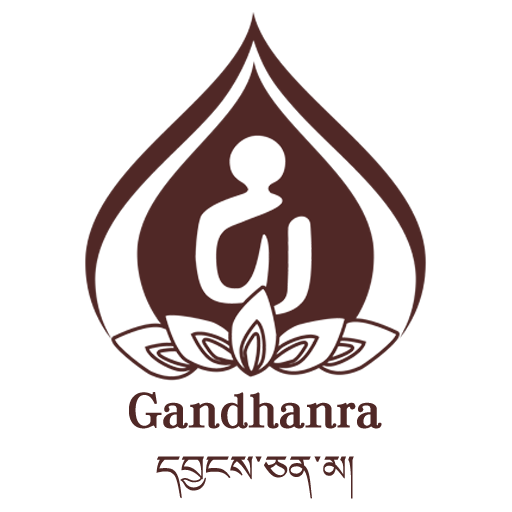

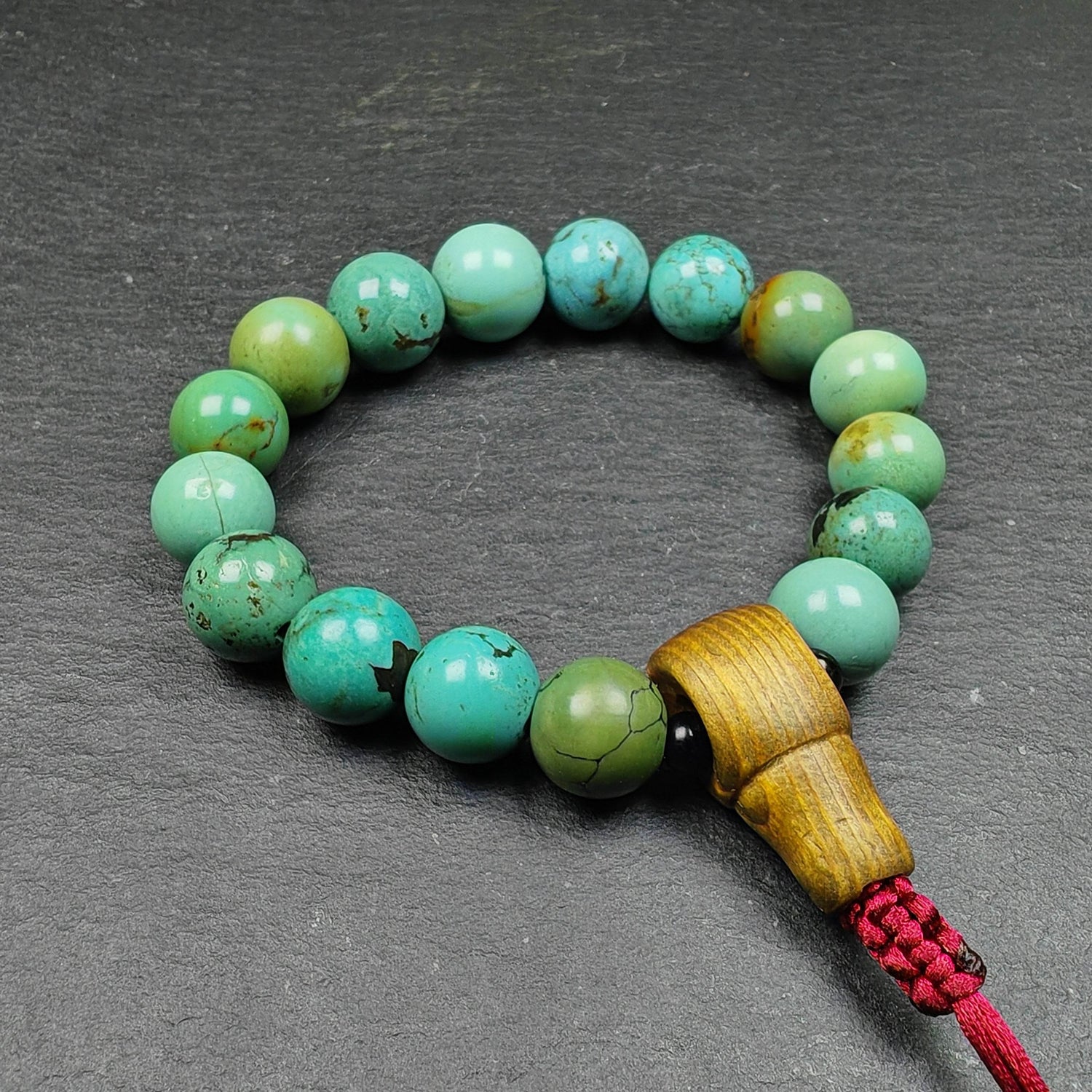
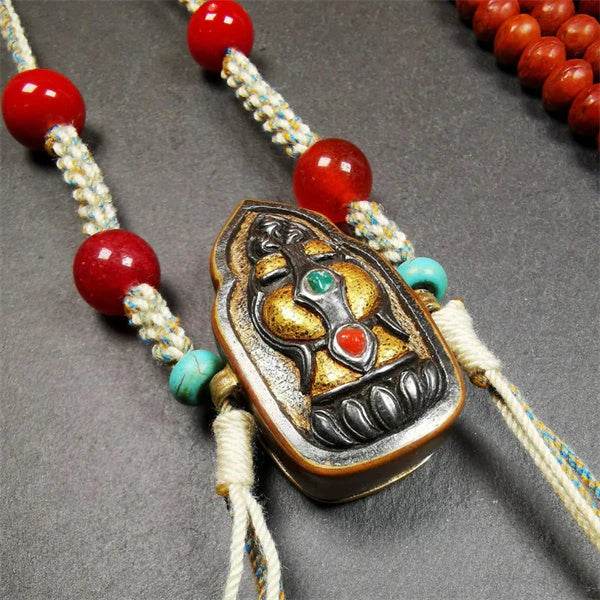

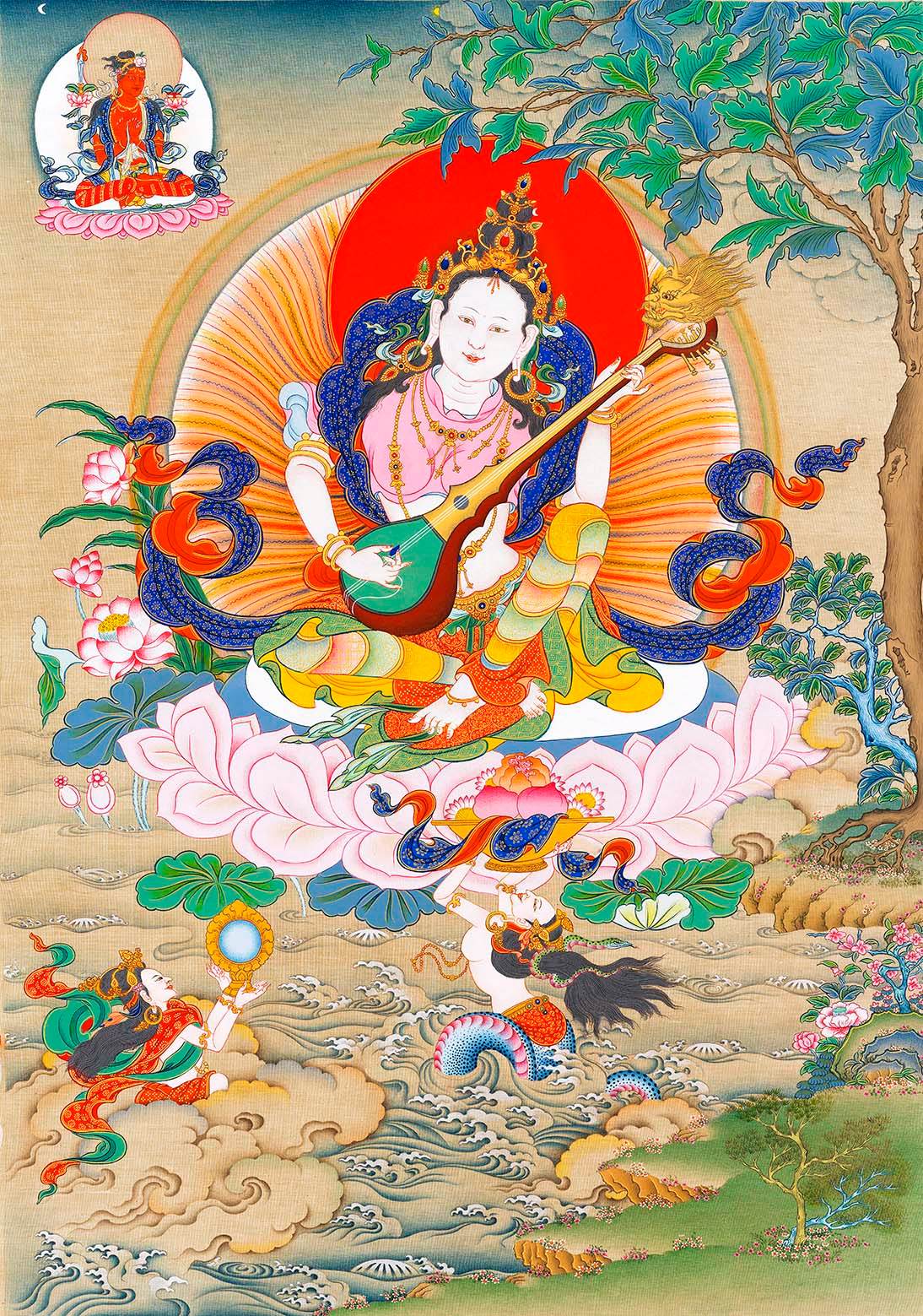

1 則留言
ojihz8